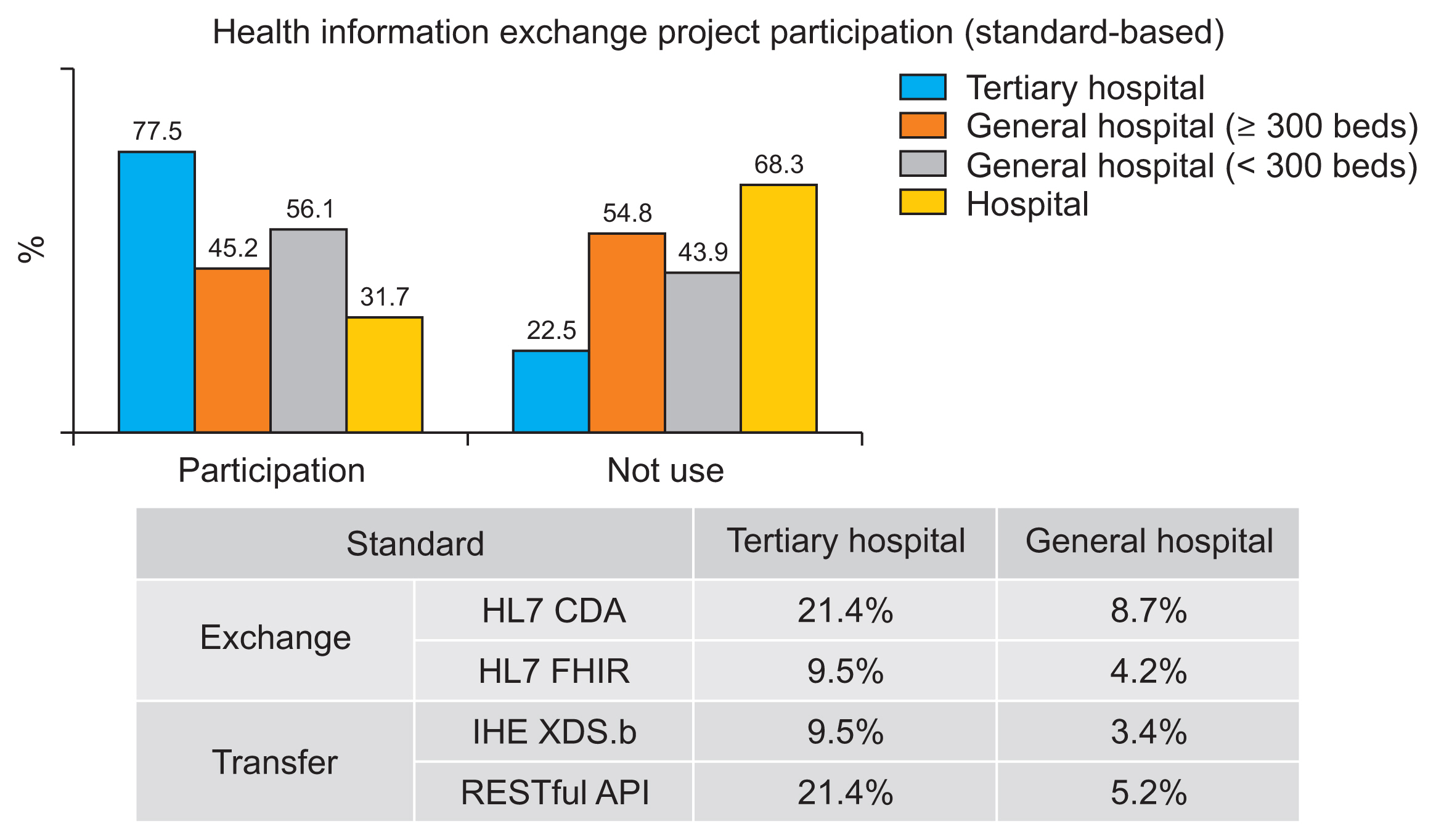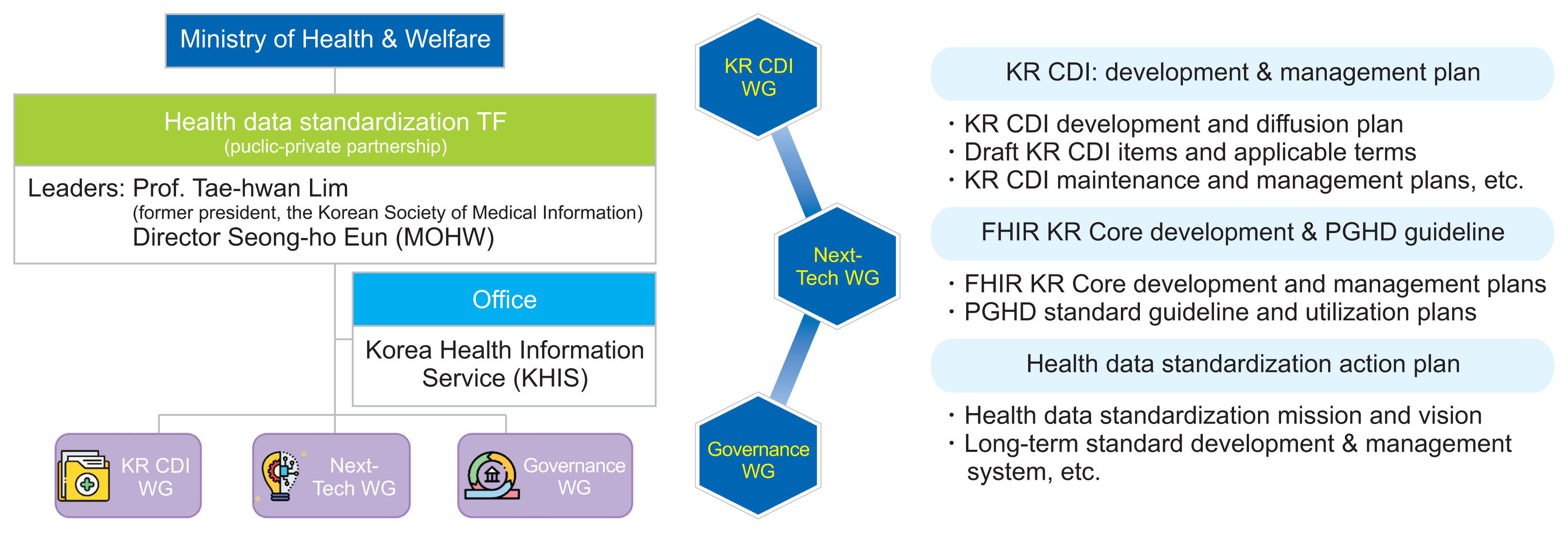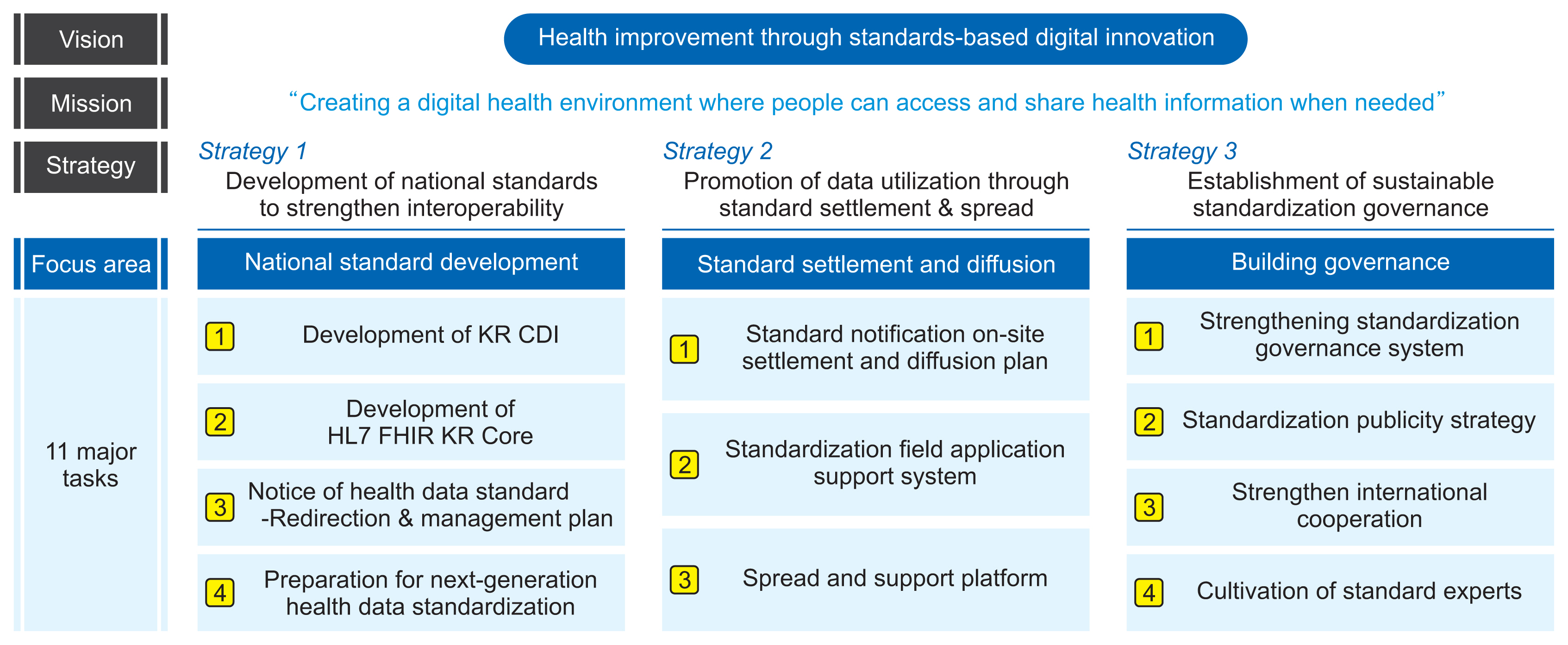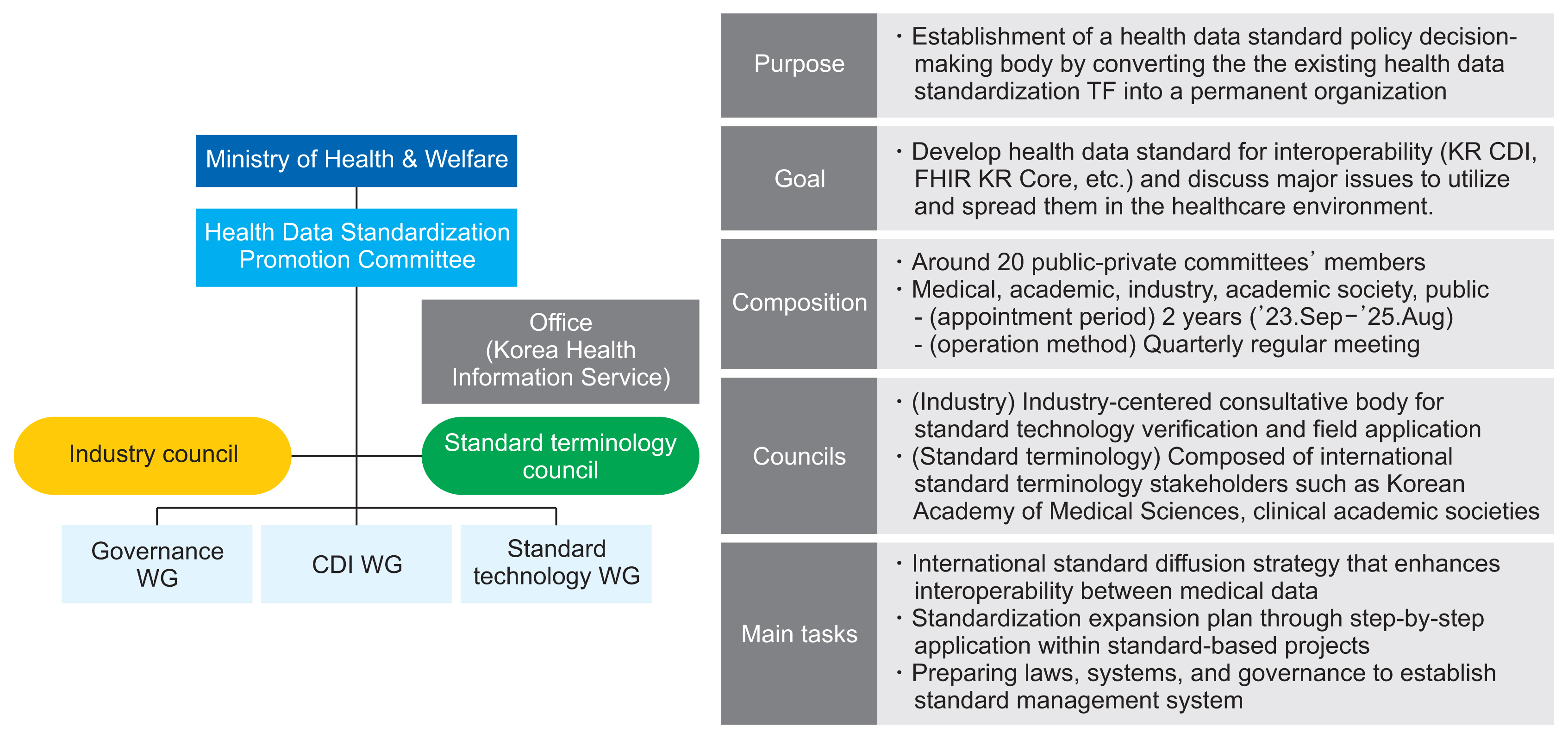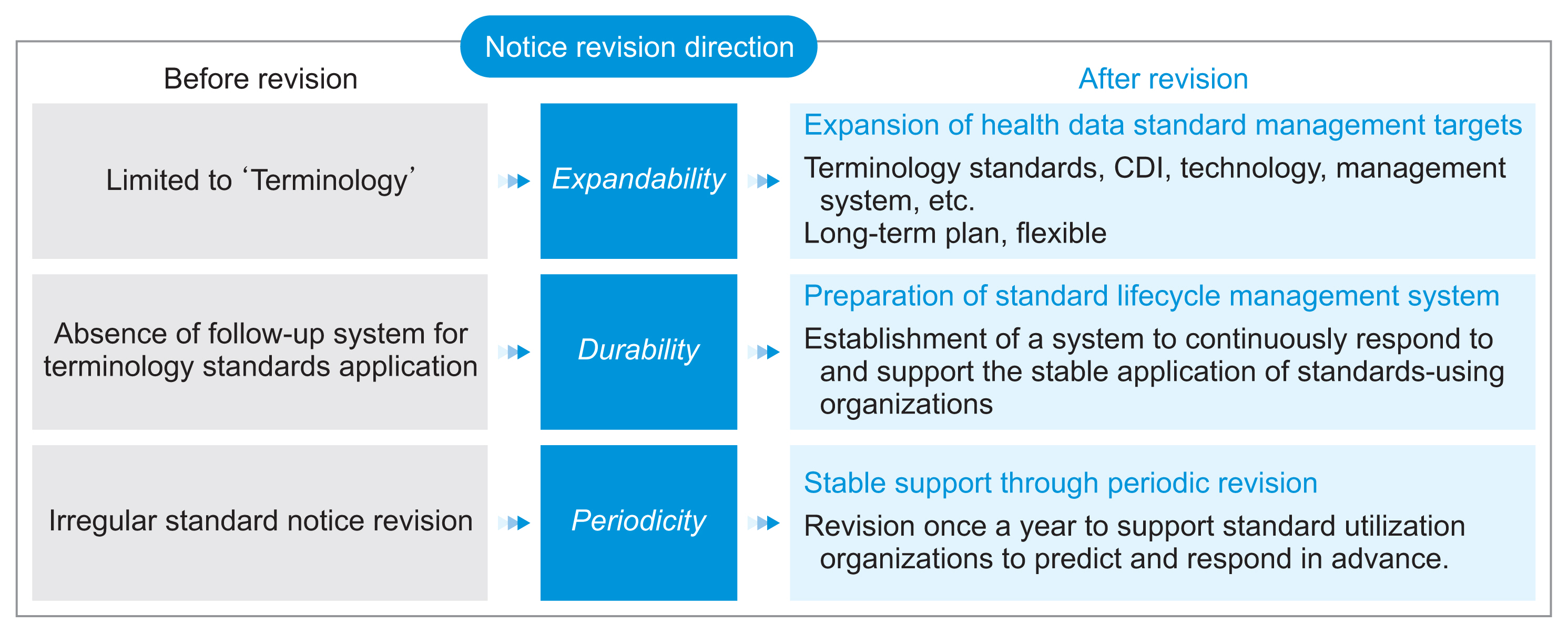Healthc Inform Res.
2024 Apr;30(2):93-102. 10.4258/hir.2024.30.2.93.
Current Health Data Standardization Project and Future Directions to Ensure Interoperability in Korea
- Affiliations
-
- 1Korea Health Information Service, Seoul, Korea
- 2Office of eHealth Research and Businesses, Seoul National University Bundang Hospital, Seongnam, Korea
- 3KakaoHealthcare, Seongnam, Korea
- 4Center of Health Promotion, Samsung Medical Center, Sungkyunkwan University School of Medicine, Seoul, Korea
- 5Department of Emergency Medicine, Asan Medical Center, University of Ulsan College of Medicine, Seoul, Korea
- 6Department of Information Medicine, Asan Medical Center, University of Ulsan College of Medicine, Seoul, Korea
- KMID: 2555209
- DOI: http://doi.org/10.4258/hir.2024.30.2.93
Abstract
Objectives
The need for interoperability at the national level was highlighted in Korea, leading to a consensus on the importance of establishing national standards that align with international technological standards and reflect contemporary needs. This article aims to share insights into the background of the recent national health data standardization policy, the activities of the Health Data Standardization Taskforce, and the future direction of health data standardization in Korea.
Methods
To ensure health data interoperability, the Health Data Standardization Taskforce was jointly organized by the public and private sectors in December 2022. The taskforce operated three working groups. It reviewed international trends in interoperability standardization, assessed the current status of health data standardization, discussed its vision, mission, and strategies, engaged in short-term standardization activities, and established a governance system for standardization.
Results
On September 15, 2023, the notice of “Health Data Terminology and Transmission Standards” in Korea was thoroughly revised to improve the exchange of health information between information systems and ensure interoperability. This notice includes the Korea Core Data for Interoperability (KR CDI) and the Korea Core Data Transmission Standard (HL7 FHIR KR Core), which are outcomes of the taskforce’s efforts. Additionally, to reinforce the standardized governance system, the Health-Data Standardization Promotion Committee was established.
Conclusions
Active interest and support from medical informatics experts are needed for the development and widespread adoption of health data standards in Korea.
Figure
Reference
-
References
1. World Health Organization. Global strategy on digital health 2020–2025 [Internet]. Geneva, Switzerland: World Health Organization;2021. [cited at 2024 Apr 30]. Available from: https://www.who.int/docs/default-source/documents/gs4dhdaa2a9f352b0445bafbc79ca799dce4d.pdf.2. Institute of Medicine (US) Committee on Data Standards for Patient Safety. Patient safety: achieving a new standard for care. Washington (DC): National Academies Press;2004.3. SNOMED International. Members of SNOMED International [Internet]. London, UK: SNOMED International;c2024. [cited at 2024 Apr 30]. Available from: https://www.snomed.org/members.4. Slawomirski L, Lindner L, de Bienassis K, Haywood P, Hashiguchi TC, Steentjes M, et al. Progress on implementing and using electronic health record systems: developments in OECD countries as of 2021 (OECD Health Working Papers 160. Paris, France: OECD Publishing;2023. https://doi.org/10.1787/4f4ce846-en.
Article5. French Ministry of Health and Prevention. Study on digital health in the EU [Internet]. Paris, France: French Ministry of Health and Prevention;2022. [cited at 2024 Apr 30]. Available from: https://ue.esante.gouv.fr/study-digital-health-eu.6. HL7 International. 2023 State of FHIR survey results [Internet]. Ann Arbor (MI): HL7 International;2023. [cited at 2024 Apr 30]. Available from: https://www.hl7.org/documentcenter/public/white-papers/23-HL7-010%20State%20of%20FHIR%20Survey%20Results%20_c3.pdf.7. Modi S, Feldman SS. The value of electronic health records since the Health Information Technology for Economic and Clinical Health Act: systematic review. JMIR Med Inform. 2022; 10(9):e37283. https://doi.org/10.2196/37283.
Article8. Gettinger A, Zayas-Caban T. HITECH to 21st century cures: clinician burden and evolving health IT policy. J Am Med Inform Assoc. 2021; 28(5):1022–5. https://doi.org/10.1093/jamia/ocaa330.
Article9. Gordon WJ, Gottlieb D, Kreda D, Mandel JC, Mandl KD, Kohane IS. Patient-led data sharing for clinical bioinformatics research: USCDI and beyond. J Am Med Inform Assoc. 2021; 28(10):2298–300. https://doi.org/10.1093/jamia/ocab133.
Article10. Barker W, Charles D. Hospital capabilities to enable patient electronic access to health information, 2021 (ONC Brief no 61 [Internet]. Washington (DC): Office of the National Coordinator for Health Information Technology (ONC);2022. [cited at 2024 Apr 30]. Available from: https://www.healthit.gov/data/data-briefs/hospital-capabilities-enable-patient-electronic-access-health-information-2021.11. Lee JH, Lee HY, Lee SY, Kwon AK, Lee GJ, Sung YN, et al. Standardization project and direction to ensure interoperability of healthcare data [Internet]. Seoul, Korea: KOSMI Issue Report;2023. [cited at 2024 Apr 26]. Available from: https://www.maillink.co.kr/agency/html/20231229/REPORT6.pdf.12. Korea Health Information Service. The 2020 National Health Informatization Survey [Internet]. Seoul, Korea: Korea Health Information Service;2021. [cited at 2024 Apr 30]. Available from: https://www.k-his.or.kr/board.es?mid=a10306040000&bid=0005&tag=&act=view&list_no=283.13. Korean Law Information Center. The Notice of Health Information Exchange Standard [Internet]. Sejong, Korea: Korean Law Information Center;2021. [cited at 2024 Apr 30]. Available from: https://www.law.go.kr/LSW/admRulLsInfoP.do?admRulSeq=2100000202199.14. Korea Health Information Service. KR CDI [Internet]. Seoul, Korea: Korea Health Information Service;c2023. [cited at 2024 Apr 30]. Available from: https://hins.or.kr/menu.es?mid=a10310000000.15. Office of the National Coordinator for Health Information Technology (ONC). Standards Version Advancement Process [Internet]. Washington (DC): ONC;2023. [cited at 2024 Apr 30]. Available from: https://www.healthit.gov/isa/standards-version-advancement-process.16. Korea Health Information Service. MyHealthWay [Internet]. Seoul, Korea: Korea Health Information Service;2023. [cited at 2024 Apr 30]. Available from: https://hins.or.kr/fhir/MyHealthWay/.
- Full Text Links
- Actions
-
Cited
- CITED
-
- Close
- Share
- Similar articles
-
- Standardization for Promoting Interoperability of Healthcare Data: The Progression of the Korean Society of Radiology
- Clinical Terminologies: A Solution for Semantic Interoperability
- Use of clinical terminology for semantic interoperability of electronic health records
- Contribution of Clinical Archetypes, and the Challenges, towards Achieving Semantic Interoperability for EHRs
- Perspectives on Clinical Informatics: Integrating Large-Scale Clinical, Genomic, and Health Information for Clinical Care

